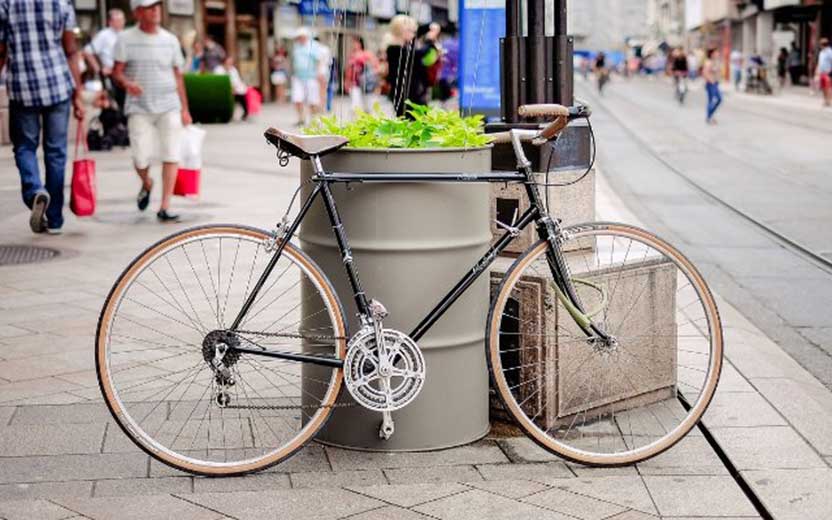By Marcus Fernandez
Many people never graduate to fully fledged cyclist because they’re too nervous about cycling on the road. Concerned with cycling safety, they prefer to stick to the sidewalk or trail for their journey, seeing these as the safer options. But while you may have less chance of colliding with a motor vehicle when riding on the sidewalk, cycling this way is sometimes inconvenient. For starters, there are the pedestrians around whom you have to negotiate, as well as the endless curbs you have to bump up and over – not to mention the legal, or rather illegal, aspects of riding on the sidewalk in some cities. And while a trail may offer you a scenic route, it’s unlikely to provide you with a route as direct as that of a road network.
With Florida ranked at the top of the list for bicycle fatalities, it’s understandable that some cyclists are a little nervous about riding on the road. According to the Insurance Institute for Highway Safety, 73% of bicycle fatalities occur in urban areas. Traffic can move fast, and, of all road users, cyclists are the most vulnerable. However, cyclists and motorists can exist safely on the roads – and do. The following will help prepare any cyclist who wants to make the transition from sidewalk or trail to road.
Cycling Safety Tips
Positioning
One of the most important aspects of road cycling safety is to always ensure that other road users know you are there. You do this not by wearing garish colors or by using flashing lights, but by positioning yourself correctly. One mistake many cyclists make when first taking to the road, is to cycle too close to the curb. This is a dangerous position to adopt because you leave yourself little room for maneuverability: If you need to swerve out of the way of a pothole, or a parked car, you risk moving into the path of a vehicle traveling behind you. Always position yourself well away from the curb when cycling. This will also allow you to avoid any car doors opening unexpectedly in your path.
Predictability
As a cyclist, always be predictable. If other road users know what you’re going to do, there’s less chance of an accident occurring. Similar to driving a car, one key to cycling safety is to always indicate when you want to make a left or right turn (first having checked behind you that it’s safe to do so).
When making a left turn, indicate as you move away from the right side of the road. If traffic is stationary waiting on a red light, take your position in the queue. Don’t cycle up to the front of the queue of traffic unless you know there’s adequate space and that you’ll be visible – for example, if there’s an advanced stop line or bike box designated for cyclists to enable them to move off once the lights have changed in view of the motorists behind them. The same applies when traveling straight on at traffic lights. If you move to the front of the queue of traffic and enter the bike box as the lights change, you may not be visible to a driver as he or she makes a right turn.
Never ride in a right turn only lane if you’re traveling straight on or turning left. To allow vehicles to turn right, move over to the right side of the left lane, at the appropriate time, indicating your intention.
Try to avoid swerving and keep a predictable, steady course at all times.
Anticipate
Critical to road cycling safety is for bicyclists to always try to anticipate what other road users are going to do. For example, if you’re approaching a car that’s parked by the side of the road and you see someone get in it, anticipate that the car may shortly pull away. Similarly, if a car overtakes you and comes to a stop by the side of the road, anticipate that the driver may open the car door in your path. And if a car slows down as it’s approaching a junction, and the driver hasn’t indicated that the vehicle’s turning, anticipate that it probably will.
Eye Contact
Wherever possible, always make eye contact with motorists. This acts as a non-verbal communication between the two of you, which says, “I’ve seen you and I acknowledge your presence.” It is one of the most effective ways to stay safe on a bike when cycling in traffic. It lets the other road user know that you’re there, and gives you the reassurance that he or she has seen you.
Other cycling safety tips to keep in mind:
- Never make breaking the law a habit when cycling. Not only does this infuriate other road users, but it’s not a good practice to get into. While jumping a red light may seem pretty innocuous to you, it could result in a collision with tragic consequences.
- Always cycle with lights on your bike in the dark and wear reflective clothing. Likewise, fit a bell or horn to your bike – or shout! – to alert others to your presence when necessary.
- Have your bike regularly serviced. It’s much easier to ride safely on a bike that works properly than one that doesn’t. It can be difficult, not to mention a little dangerous, to negotiate busy intersections if the gears on your bike are constantly slipping.
While you’re a little closer to the traffic on the road than you are on the sidewalk or trail, remember that you’re perfectly entitled to be there. In fact, it’s where you, as a cyclist, belong. So start using your vehicle for what it was built for. Once you take to the road, it’s a guarantee that the only time you’ll ever look back is check what’s coming behind you.



